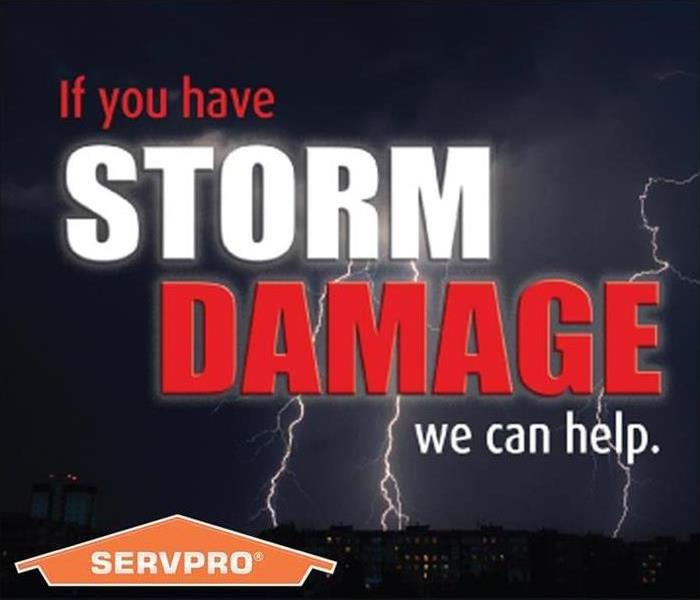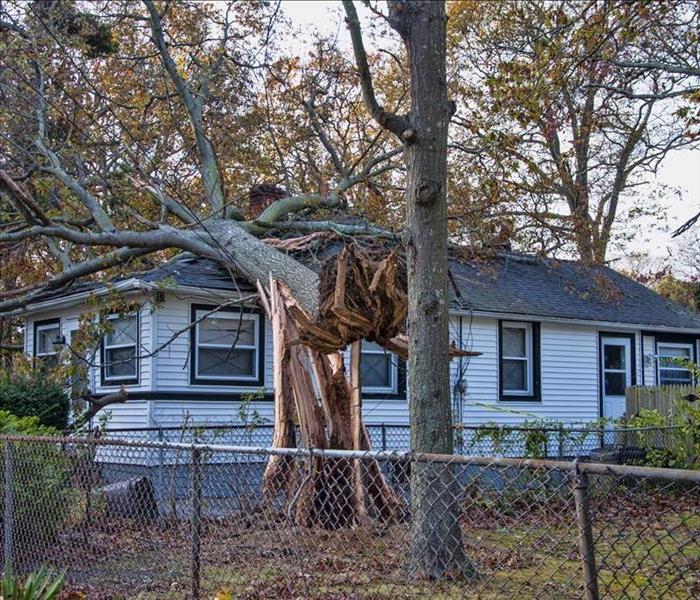Recent Storm Damage Posts
Tornado Damage
9/26/2024 (Permalink)
Tornadoes aren’t something you usually think you must worry about. Typically, you think they mostly occur in places like tornado valley, but they can happen all over the country. In 2024 Michigan has had a total of 11 tornadoes so far, that may not seem like many but the overall property damage that these caused totaled over 50 MILLION Dollars. Overall, the state has had over 1200 recorded tornadoes causing over 1.3 billion dollars!
The most common ways homes get damaged by them is when the wind pushes up shingles and water is allowed to enter the home, or when flying debris damages gutters or siding when they make impact. Trees are also known to uproot and fall onto homes causing holes in the roof.
The question then becomes, “What happens if my home is damaged by one of these terrible twisters?” The answer is to call SERVPRO®! We can help with any water intrusions due to storm or tornado damage and make it, "Like it Never Even Happened!"
Storm Damage Resources
7/31/2024 (Permalink)
SERVPRO® specializes in storm and flood damage restoration. Our crews are highly trained and we use specialized equipment to restore your property to its pre-storm condition.
Faster Response
Since we are locally owned and operated, we are able to respond quicker with the right resources, which is extremely important. A fast response lessens the damage, limits further damage, and reduces the restoration cost.
Resources to Handle Floods and Storms
When storms hit Metro Detroit, SERVPRO of Oak Park/Ferndale can scale our resources to handle a large storm or flooding disaster. We can access equipment and personnel from a network of over 2,000 Franchises across the country and elite Disaster Recovery Teams that are strategically located throughout the United States.
Have Storm or Flood Damage? Call Us Today 248-246-0790
We Are Here To Help
6/18/2024 (Permalink)
Major storms often bring violent weather, and with violent weather storm damage usually always occurs. Strong winds either from a storm or a tornado can cause chaos for a home or business owner. Knowing how to handle the situation if storm damage happens to your home or business could mean everything. It also helps when it comes to protecting not only your belongings, but your safety and the safety of others.
Source
Storm damage can occur from a number of different things. Strong winds can cause shingles or tiles on roofs to become loose, and uproot trees. Wind is usually associated with rain. The damaged roof allows water or moisture to get inside of the home. This will cause damage to ceilings, walls, and even worse, cause the potential for mold growth. Hail during a storm can also cause significant damage to a roof. Then there is Lightning and what that can do.
**Handling the Issue**
Any type of damage to a home or business can be very overwhelming for anyone. Call a professional restoration company such as SERVPRO®, an Industry Leader in the restoration industry every year. SERVPRO of Oak Park/Ferndale will help by acting quickly on getting the problem solved, and minimize the impact the damage has done to your home or business.
**Safety**
First thing a home or business owner should do with water coming inside from a roof leak is make sure the power to the home or business is shut off. Storm water can soak into walls reaching electrical wiring. This also could be done with the water supply if any pipes are broken, and or the sewage system is clogged or backed up.
**Assessing Damage**
This is where a professional restoration company comes into play. Our trained experts will do an examination of the home or business. We thoroughly check the property. We will work with your insurance company by taking photos of the damage for insurance purposes, and following insurance policies. SERVPRO is a Nationally Preferred Vendor to most Insurance companies and works directly with your Claims adjuster on your behalf.
**The Clean Up*
Once the roof is taken care of temporarily with a tarp or permanently, the clean up can start to happen. We will clean up the water making sure every inch is dry using our professional expertise, using the right equipment needed to get the job done. Whether it is using vacuums and pumps to remove the water, dehumidifiers and air movers to stop mold and mildew before it even happens, to generators if needed to operate our equipment. We will also take the necessary steps in making sure everything is done correctly. We will remediate mold if the water has been sitting for any length of time. We will pull carpet or wet flooring if not salvageable, and disinfect hard surfaces, shampoo savable interiors, and deodorize to stop any odors.
When contacted as soon as the first notice of loss has happened we will be able to save your home or business from a bigger issue. Even the shortest of storms can do a big amount of damage. Our goal is to fix, clean, and get your property back to its preloss condition!! “Like It Never Even Happened!”
SERVPRO of Oak Park/Ferndale. Available 24/7 (248) 246-0790
SERVPRO Storm Teams Help Save The Day - Again !!!
9/26/2023 (Permalink)
When a major storm hits, SERVPRO® of Oak Park / Ferndale can scale our resources by accessing the equipment and personnel of 2,000 Franchises with the Resources to Handle Storms and Disasters. Last month, at the end of August, was just that scenario here in the Greater Metro Detroit area and Lower Michigan. A large part of these areas were hit with 5-7” of rain in a 36 hour period. Basements flooded, roofs leaked, and there were a ton of sewage back-ups.
Here at SERVPRO of Oak Park / Ferndale alone we took roughly (40) calls in two days, while other local restoration companies were simply overwhelmed. Luckily for us we had a plan. We reached out to our SERVPRO STORM TEAM for help!!
Essentially, the call went out to our many franchises to bring teams and equipment to the affected areas to get help to those in need. Within (2) days we had over 35 additional teams in place working the storm. Most were here for several weeks, away from their families till the work was completed. That’s the Power and Vision of SERVPRO®.
We can also access our National Disaster Recovery Team staged in regional parts of the USA, ready to respond in the event of major storms and catastrophic events.
Always ready when you need us. SERVPRO of Oak Park/Ferndale (248) 246-0790
"Like it Never Even Happened"
Tornado Safety Tips
7/14/2023 (Permalink)
Big summer storms can sometimes lead to scary situations. Perhaps none bigger than the threat of a Tornado. Years ago, we never received advanced warning. Today the meteorologists have access to so much new technology, that they understand these storm systems and can predict when and where the biggest threats are. We can get Alerts right to our cell phones or across our televisions. It should give you “Peace of Mind”… IF you heed their advice!!
You've heard for years to keep an Emergency Kit/Supplies somewhere just in case. Water, batteries, dry food goods. It's too late once you get a warning of a potential Tornado in your vicinity. Also there is a difference between a “Watch” and a “Warning”.
-Tornado Watch - Conditions in the atmosphere are right for one to potentially develop. Be Prepared. Charge your cell phones.
- Tornado Warning - Radars have picked up Stronger winds with Rotation and Debris heading in your general direction. Take cover, follow your plan.
If you have a basement, you should head there. If not, it should be a room in the center of your home, preferably with no windows. A bathroom with no windows is better. The walls of your bathroom contain the plumbing pipes so it will usually be structurally stronger. Lets hope you never experience this kind of storm, but being Prepared is worth doing. But if you do, call SERVPRO® to help you through this recovery.
SERVPRO of Oak Park/ Ferndale We are here for you. (248) 246 - 0790
Storm Preparedness - Being Proactive
7/7/2023 (Permalink)
Bad weather can spring up at any time, especially here in Michigan. Most of the time when a large thunderstorm “Rumbles” thru here locally, we have little time to react.
As a homeowner it's important for you to have a Preparedness Plan in place. Some very easy steps are:
- Having a case of water set aside
- Dry goods/food/snacks to eat
- Batteries for flashlights in the case you lose power
- Car plug adapter to charge your cell phone
Simple stuff right?
Next, you should keep a plastic tarp somewhere handy in case you need to cover something up, like a hole in your roof from tree damage caused by the strong winds. Tarps are pretty inexpensive and when folded up, take very little space to store, but can save your home from worse water damage.
Now, a simple call to your Insurance Agent to confirm the type of coverage you have for storms. Flood coverage? Sewage back-up? These are typically different coverages. Verify this information and make adjustments you feel you need for your peace of mind. Once the storm is here… it's too late.
If you do suffer Storm Damage, file the Claim right away to get things rolling. Then call SERVPRO. We are an Industry Leader in Storm Restoration along with Fire and Mold. With over 2,000 locations we are always ready to assist you 24/7 and are an Approved Preferred Vendor for most of the National Insurance Carriers. Still Pretty Simple, Right?
SERVPRO of Oak Park/ Ferndale (248) 246-0790
Like It Never Even Happened
Storm Damage
7/5/2023 (Permalink)
Storm damage can come in many different forms and affect your home in different ways as well. Did your flooded street back up into the sewer system in your neighborhood? Did storm winds bring down a tree or large limbs, damaging your roof or taking down electrical lines? No electricity…means no sump pump to push unwanted water or sewage back outside. Roof damage means the rain is probably finding its way into your house from above. Any water damage is bad news.
If you're thinking you'll use towels and a mop, it's a good first step, but not enough. You're not getting to the water you can't see, but it's still there. Does it contain bacteria? Will these hidden wet areas become Mold? Don't take that risk. Call SERVPRO®.
Our experienced technicians will use their Advanced Industry approved equipment to extract the water and locate the hidden wet areas with moisture detection devices. Well dry it out properly and thoroughly so you can get back to your daily routine faster and with Peace of Mind. SERVPRO works directly with your insurance claims adjuster on your behalf. One less thing you need to worry about. We are available 24/7.
The SERVPRO of Oak Park/ Ferndale Team is always here to help in your time of need.
(248) 246-0790
Summer Storm Tips
6/15/2023 (Permalink)
Tips To Help Avoid Summer Storm Damage
Most of us think we are prepared for Emergency situations, until they regrettably happen. Then it's time to call SERVPRO. We’ll get you through it!
However, there are some things you can add to your “I’m prepared” list to help avoid these storm issues. Two big items for your list are;
1) Clean out your gutters every spring from the Fall leaves
2) Check your basement Sump Pump
And here's why !!
Heavy rains in a big storm, flowing down your roof is supposed to drain away from your home via the gutters and downspouts. If they are clogged, the rain will most probably be running down your homes outside exterior walls. All that water can potentially pool as standing water at the base of your foundation. Not a good thing. Additionally, if your street's sewers can't handle all the rainwater, it needs to go somewhere. This could be your home and or basement.
Check your Sump Pump periodically. Pretty simple to do. Fill a large bucket with water and pour it into the reservoir your sump pump sits in. It should come on and move the water back outside where it belongs. If it doesn't, get it fixed so it's ready for your next big storm.
Hope this helps and gives you some peace of mind.
SERVPRO Ferndale/ Oak Park - Like It Never Even Happened
(248) 246-0790
SERVPRO TEAMS UP WITH OTHER SERVPRO'S TO HELP ONE ANOTHER.
10/17/2022 (Permalink)
SERVPRO individual franchises are helping cities all over the states when a hurricane, tornado, or a storm happens. SERVPRO Professional technicians will travel across into other states to meet with other teams and work together to achieve the goal of Clean up and Restoration. An Alert is sent out to all franchises as to what the situation is, and each franchise considers whether they can send out a team to travel to the affected area. SERVPRO has been in the business of Cleaning and Restoration for 50 years and will continue to strive to be the number one Restoration Company across the United States. If you are looking to find out if you have SERVPRO Teams coming into your state when a disaster hits, call your local SERVPRO for more information.
Metro Detroit August 2022 Storm
9/9/2022 (Permalink)
Metro Detroit experienced a storm the last week of August 2022. It swept through quickly but in its wake caused serious damage. Many cities experienced massive trees being pulled up by their roots. Branches fell on to homes and cars. A storm could last minutes and cause severe clean up that needs to take place. SERVPRO is a company that comes into a home or business, garage, any structure, also outside if needed and assists with demo and major clean up. Our team is trained in how to access these losses. They study the destruction with the owner, production manager and team and come up with a plan that best suits the needs of that loss. Training, experience, hands on, discussion, communication and hard work as a team is what SERVPRO prides itself on. If you have storm damage and need a Professional Restoration Company, give SERVPRO A CALL TODAY. #248-246-0790
Who predicts the storms and how?
7/18/2022 (Permalink)
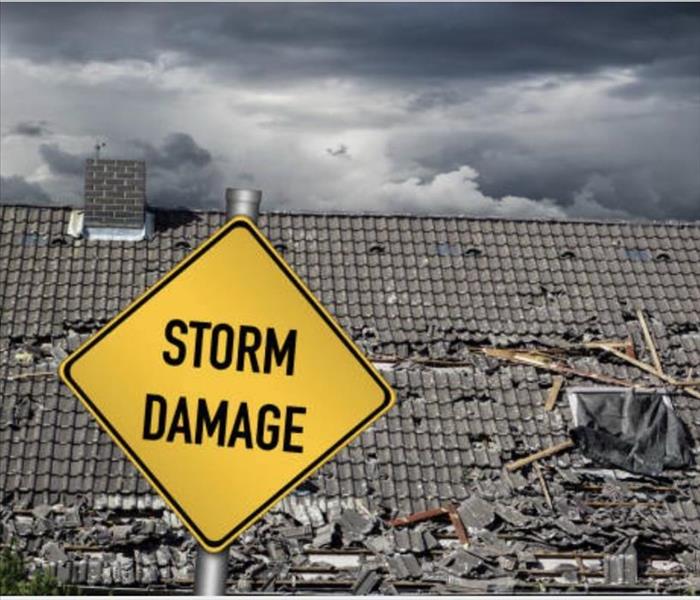 An indication of what happened here. Nature took it by storm.
An indication of what happened here. Nature took it by storm.
Meteorologists, also known as Forecasters are scientists who study the conditions of weather. Many tools are used to predict storms coming all around the world. What tools do they use? Surface maps, radar, and satellites. Surface maps help indicate high or low pressure. High pressure gives us the beautiful sunny skies. When low pressure is stipulated we are heading in a stormy direction. Computer forecasting models are used for different scenarios of what could happen within the atmosphere. Everyday millions of monitoring time from satellites are recorded. Meteorologists have dozens of these models to observe and any slight changes in the atmosphere can cause a different result. Technology has come a long way over the years in aiding us with warnings of storms so we can do our best to protect ourselves.
If your home or business fell victim to storm damage, please call your local SERVPRO. We are a preferred vendor to many insurance companies. SERVPRO of Oak Park Ferndale-248-246-0790.
Storms and Generators
7/11/2022 (Permalink)
Storms come and go. Some regions get hit hard while other communities are fortunate to miss the chaos. I remember in 2014 the storm that hit my section here in Michigan, my bellow stairs were flooded 3 feet deep. I pretty much lost everything down there. Collectively, so did many of my neighbors. The neighborhood had storm drains backed up in almost every lower area of their home. What a mess! We lost power. I did not have a portable generator. I still don’t. It’s time. Storms are forever unpredictable. I decided to look up information on what kind of generator I need and there is much to learn. Here are a couple of important factors I did not know. Without a transfer switch, (We need that switch!) a portable can not power hard-wired appliances. (Well pump or furnace) It is best to consider appliances that are most important that you can plug in to an extension cord. It is a must to find the wattage requirement of each appliance. (That is on the refrigerator or stove itself. You need to look for it.)
Watts=Amps x volts
(EXAMPLE)
If your mechanism draws 20 amps from a 120-volt outlet that would mean you would need to times (20 x 120) of electricity. That device would then use 2,400 watts of electricity.
It is important to research so you have some knowledge on what you need. Then speak with a professional that is well equipped to help you choose what is best.
Storm, Storm go away, please don’t come back any day!
Would you like a storm to be named after you?
7/7/2022 (Permalink)
Have you ever wondered how storms are named? If you are like me and enjoy researching new topics, you will be surprised of the interesting history behind these names. I can give you a brief summary, but I do recommend you read on this subject for yourself.
Storms were once called by their latitude and longitude. Which caused much confusion and errors. By the late 1800’s a formal naming system was cultivated by the United States Navy, in which the hurricane for example would be named after the ship’s commanding officer, wife or another female relative.
Storms originally started with female names. But, in 1978 according to research, the public was outraged by the absence of male names. Today, both are used. In 1978, both female and male naming has been rotated for Pacific and Atlantic storms. You can check to see if your name is on the list by going to: World Meteorological Organization. Many names have been retired (86 to date) and some are even renamed.
Here are a few names that potentially may be used for Atlantic Storms in 2022.
Bonnie
Julia
Danelle
Fiona
Ian
Owen
Virgine
Walter
What months are the most common for storms?
6/21/2022 (Permalink)
Ever wonder when storms our most likely to occur throughout the year? You will have a better idea on how to prepare if you know the pattern of behavior. Storms can come at any time, but to my surprise April, May and June are the most active Months. Growing up in Michigan I honestly thought July and August were the hottest most humid months of the year. My Michigan people, do you agree? The main components to a thunderstorm are rapid rising warm air and moisture. By the way, today is officially the first day of summer. June 21st and will end on September 22nd.
*Interesting Facts*
A Texas storm in 1995 poured hailstones as large as softballs. 16,800 people lost power. It was reported that within 1 hour, some of the roads in Fort Worth were buried under 2 feet of hailstones.
September 2017, Labor Day weekend to be exact. In Northern California a heatwave turned grapes into raisins. The sweltering heat desiccated the moisture from the grapes. It was estimated that wine vineyards lost up to 50 percent of their harvest.
To your advantage in a storm situation, SERVPRO IS HERE TO HELP!
Worst Storm in History
10/15/2021 (Permalink)
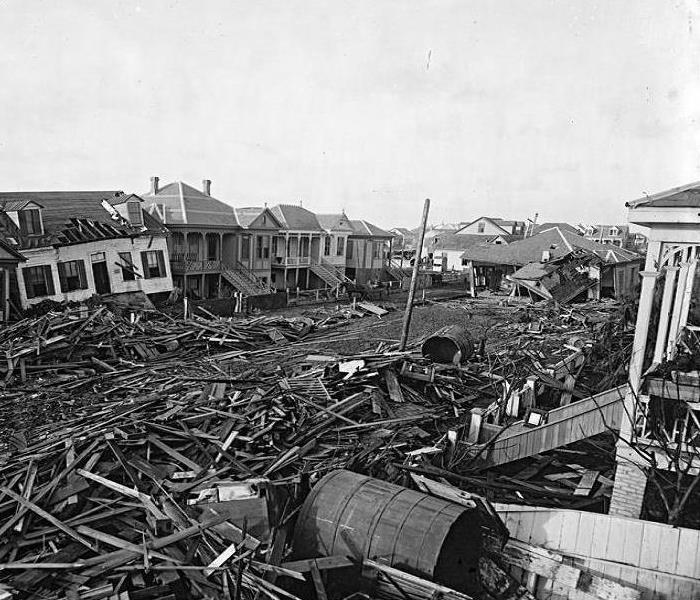 Galveston Texas Number 1 on the list of worst storms in US History.
Galveston Texas Number 1 on the list of worst storms in US History.
I came across an article a few weeks back and found some information on some of the most devastating storms in the US. Had me thinking to look up what storm has been the worst in US history. According to my research Galveston Texas September 8th, 1900 was the worst natural disaster with winds at 135 MPH. Leaving 8,000-12,000 lives to perish. It is said that complacency among the towns people played a role to some degree, that the people were warned it was coming. All storms are categorized between 1-5. Five being the worst. This storm was considered a four. I thought, back in those days the houses and most businesses were not built as strong as they are now. What could the people have done to prepare for a storm of this magnitude? I would think…NOT MUCH.
Essentials in preparation of a storm.
9/23/2021 (Permalink)
Ask yourself, how well prepared are you if a storm comes through and you find yourself in a situation that you have never experienced? You may want to strongly consider having a real plan.
Have a list. Whether on paper or on your phone. (Both would be awesome)
Depending on the situation, you should know where to go and where to stay in place. What items you need for protection.
*Here we have a list of items that will be of help in a critical position.*
~Flashlight and batteries. (EXTRA!)
~Emergency phone numbers.
~Daily Medication
~All personal identification, cash, cards, bank information and important documents. (I SUGGEST KEEPING THESE ALL IN ONE PLACE AND A WATERPROOF CONTAINER)
~Nonperishable foods with a hand can opener.
~First aid kit.
~Bottled water. (As much as you can take)
~Change of clothes and a jacket.
~Waterproof boots and sturdy shoes.
~Blankets depending on the weather and time of year.
~Having a disposable camera for any documentation would be great.
SERVPRO CARES ABOUT YOUR SAFETY.
INTERESTING FACTS ABOUT STORMS
7/21/2021 (Permalink)
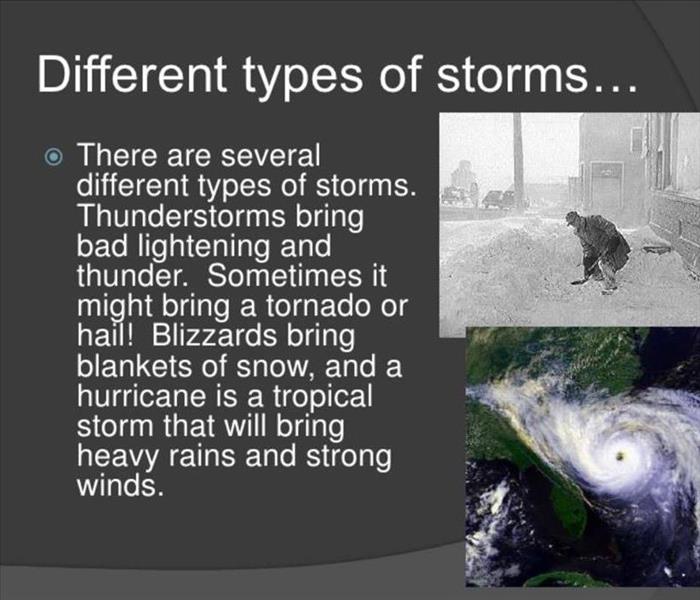 Words to match that we certainly have different types of storms.
Words to match that we certainly have different types of storms.
- HAIL STORMS-They cost an estimated $ 1 Billion a year when present. Hail can be small or very large and cause major damage due to dents, roof leaks and eventual water leaking into structures.
- THUNDERSTORMS-Very dangerous and highly incalculable these storms cause flash flooding. Thunderstorms can produce up to 30 feet of water causing trees and buildings to be torn out.
- WINDSTORMS-Some winds can reach up to 120 mph. Knocking down powerlines and up rooting trees. The demolition happens when the winds reach to speeds of 40-50 miles per hour. These storms can actually equal the damage of tornadoes.
- TORNADOES-Summer and Spring are when tornadoes are most likely to take place. Tornadoes can transcend over 300 mph! Anything can be pulled up out of place and thrown around causing the most dangerous threat. Thunderstorms release the vigor that puts the tornado in motion.
- BLIZZARDS-Heavy snow could cause roofs to collapse under the weight along with freezing temps and high winds and eventual snow melting causing water damage to get into a structure of any building or home.
- ICE STORMS-In freezing temps the snow can cover any surface and become a heavy piece of ice. Breaking and causing just as much damage as the heavy snow.
- HURRICANES-These winds are categorized between a 1 and 5. They could reach up to 157 mph. Any properties can be destroyed in the wake of a hurricane.
- SAND STORM/DUST STORM-Gusts of wind blow fine particles of sand that stay suspended in the air. If you are unfortunate to be caught up in this storm, over time these particles could be responsible for different kinds of health effects. Sand Storms rarely go above 50 feet from the ground.
Do you know the difference between a STORM WARNING and a STORM WATCH?
7/12/2021 (Permalink)
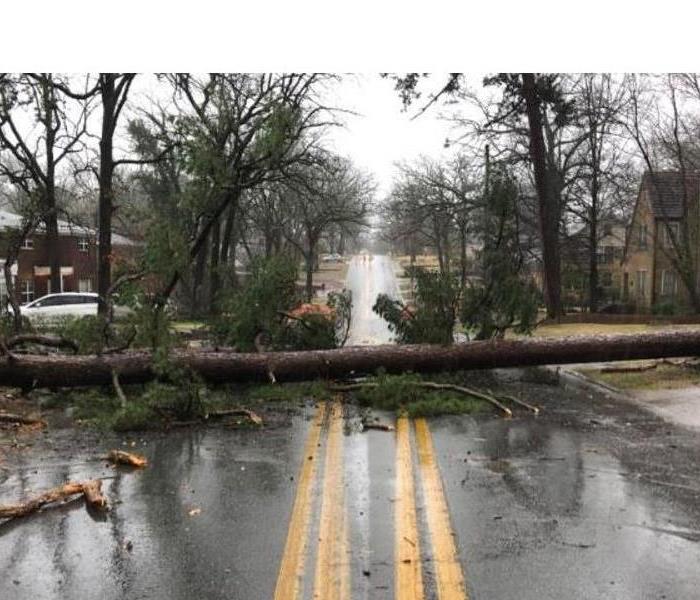 A storm can cause a tall sturdy tree to fall down in it's wake.
A storm can cause a tall sturdy tree to fall down in it's wake.
When I was growing up I would always get confused between a storm warning and a storm watch. I would see it on the news but soon forget the difference between the two. I did understand that either way the weather that day was not in anyone’s favor and it was best to avoid plans and stay where I was.
If you still have trouble with the difference as I did, I will try and make the distinction clear for you.
***WATCH WILL ALWAYS COME BEFORE THE WARNING!***
*WATCH* Meteorologists observe and track the weather all day, every day throughout all the United States. When a threat of a storm is present through tracking of rising moisture in the air. The watch is to inform the public to stay knowledgeable for any changes that are coming to your area.
*WARNING* Is enlightening you to a potential serious threat to life and property. Local National weather offices are responsible for tracking in designated areas and to let you know, you should prepare and take cover in a safe place until the threat has passed.
Waterfall Stairs
7/6/2021 (Permalink)
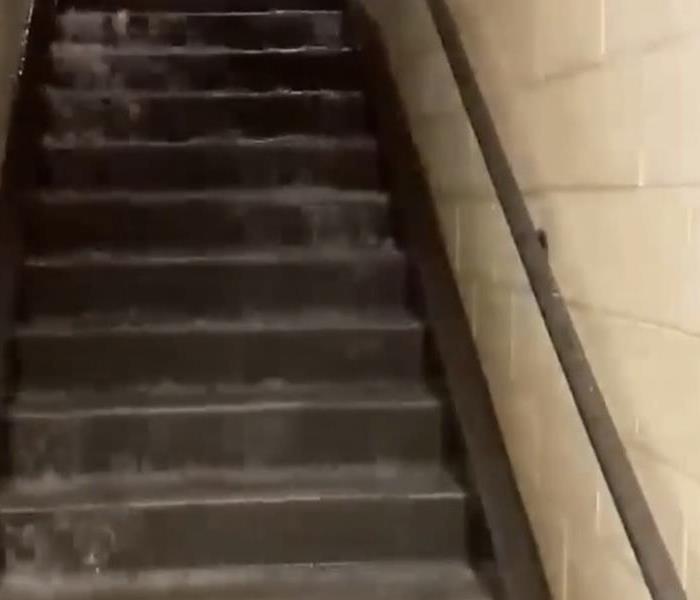 Water falling down a building stairs after a storm.
Water falling down a building stairs after a storm.
Strong rainstorm pours through the roof of this commercial building leaving the stairs looking like a mini Niagara Falls or a familiar scene from the Titanic. This was a photo taken by a young man who was in the building witnessing this in disbelief.
Storms are unpredictable and fierce. Minutes can cause a surmountable amount of harm to a building in its wake.
Here are some suggestions to keep yourself as safe as possible during a rainstorm that is invading a structure.
*You should avoid bathing or talking a shower*
*DO NOT USE ANY ELECTRONICS, SUCH AS YOUR COMPUTER, LAPTOP, WASHER OR DRYER. ANYTHING THAT COMES IN CONTACT WITH AN ELECTRIAL OUTLET!
*Find the safest place to be if you are directly in the storm and after it has passed*
“Preparation is key to any unexpected misfortune”
SERVPRO IS HERE TO HELP YOU-CALL US TODAY! 248-246-0790
Flooded Elevator
6/30/2021 (Permalink)
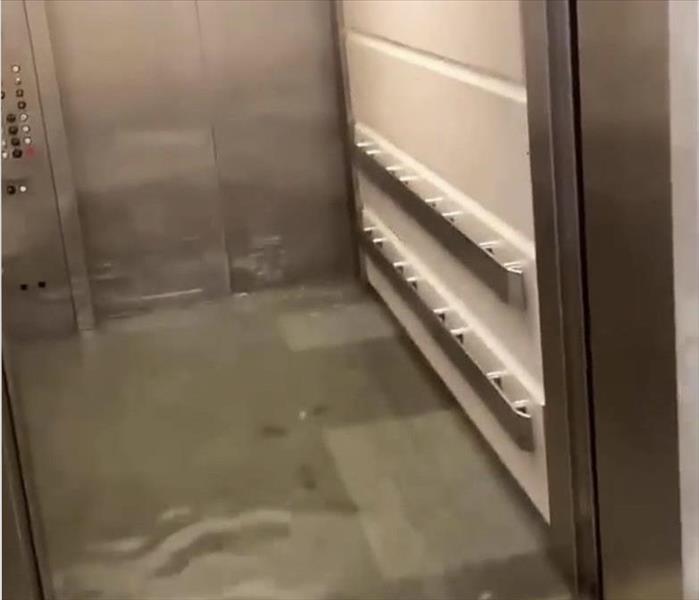 Elevator consumed by water during a rain storm.
Elevator consumed by water during a rain storm.
This large building took on water from a storm that flooded areas of this structure leaving the water to spread into the elevator with no place to go. To the surprise of people trying to use the elevator the shock of 1-2 feet of water as the doors opened was a bit frightening. Water can do as much damage as a fire in many ways, you either deal with soot from a fire or mold from the water. Both are comparable damage.
*Hidden places that water can travel, which can affect the way a device functions or could possibly completely shut down.
*Any object that is porous, spaces, holes, that any liquid or air can go directly through. Many of those items may have to be thrown out due to eventual rotting inside or unstable strength and more than likely due to the storm it may be sewer water damage even if you think it is not. SERVPRO PROFESSIONALS know the difference.
*A ceiling or structure of a building or home can cave in under the weight or winds in a storm.
*Every emergency of this kind has a uniqueness depending on how much water and where.
*Drying, containing, cleaning, disinfecting and in many cases tearing down or discarding is the same as any other unforeseen disaster.
ADVICE: If you have found yourself in an area that was hit hard with a water storm, you are correct in thinking neighbors and others have damage too. SERVPRO PROVIDES STORM TEAMS that come from all over the states to help one another out in an emergency.
Call Us today. 248-246-0790
SERVPRO Oak Park/Ferndale
SERVPRO of Oak Park/ Ferndale Storm Services
7/31/2018 (Permalink)
When you are dealing with storm, flood, and water damage, immediate action is crucial. You should choose the company with storm damage experience and expertise that has the resources and equipment to handle the job. SERVPRO of Oak Park / Ferndale can respond immediately to storm and flooding conditions.
Have Storm or Flood Damage?
Call Us Today (248) 246-0790
Why Choose SERVPRO of Oak Park / Ferndale?
We're Faster to Any Size DisasterWe’re dedicated to responding immediately to water and storm damage emergencies. A fast response lessens the damage, limits further damage, and reduces cost.
We're Highly Trained Storm Damage Specialist's
We are storm and water damage specialists who get started promptly to get your property dry and back to pre-storm condition. Using advanced equipment and scientific drying techniques, we document the drying process to validate your home or business is ready.
- Water Damage Restoration Technician
- Applied Structural Drying Technicians
We Have the Resources to Handle Storms and DisastersWhen a major storm hits, it may overwhelm local restoration companies. SERVPRO of Oak Park / Ferndale can scale our resources by accessing the equipment and personnel of 1,700 Franchises. We can also access Disaster Recovery Teams that specialize in major storms and catastrophic events.
Storm Tips
7/20/2018 (Permalink)
Storms happen no matter where you live. Some can be the same routine storms we get every year, but sometimes we can get dangerous ones that cause serious issues. You should always be prepared for when a big storm hits. Here are some tips on how to do just that.
-Keep a battery powered radio with new batteries in your home. If the electricity goes out you want to be able to tune into the radio stations to get updates.
-Every floor of your home should have an accessible flashlight. Make sure to also keep keep fresh/extra batteries with the flashlights.
-Always keep a supply of candles for power outages.
-If living in a frequent storm area take extra precaution when it comes to your roof. Nail down or use adhesive on shingles to keep the shingles from blowing off or turning.
-Trees can be a big threat during a storm even healthy trees. Cut them back if necessary to avoid damage to your house if it were to fall.
-If you live in a hurricane prone area never leave the home during the storm. Always remember to seek high ground if flooding occurs.
-When warnings of a major storm arise you should always close shutters, board windows, or tape the inside of larger panes with an X. This will try and give the windows extra strength not to crack.
-Tornado's are opposite when it comes to the windows. You should leave windows slightly open if there is a tornado threat.
-The best shelter for a tornado is under ground. The basement can work, but you should stay away from gas pipes, and sewage pipes.
Storm Damage Handling
7/16/2018 (Permalink)
Major storms often bring violent weather, and with violent weather storm damage usually always occurs. Strong winds either from a storm or a tornado can cause chaos for a home or business owner. Knowing how to handle the situation if storm damage happens to your home or business could mean everything. It also helps when it comes to protecting not only your belongings, but your safety and the safety of others.
Source
Storm damage can occur from a number of different things. Strong winds can cause shingles or tiles on roofs to become loose. Strong winds can uplift trees, or other objects that can be tossed on a roof causing impact. Wind is also but not always associated with rain. This is where the big issue lies when any type of damage is done to a roof. When dealing with a damaged roof this allows water or moisture to get inside of the home. This will cause damage to ceilings, walls, and even worse cause the potential for mold growth. Hail during a storm can also cause significant damage to a roof. Lightening is another one that can cause major damage to a home or business. It can cause branches to break off of trees, cause windows to shattered if hit, and also can start a fire.
**Handling the Issue**
Any type of damage to a home or business can be very overwhelming for anyone. Calling a professional restoration company such as SERVPRO of Oak Park/Ferndale will help with acting quickly on getting the problem solves, and minimize the impact the damage has on your home or business.
**Safety**
First thing a home or business owner should do is make sure the power to the home or business is shut off. Storm water can soak into walls reaching electrical wiring. This also could be done with the water supply if any pipes are broken, and or the sewage system is plugged/backed up.
**Assessing Damage**
This is where a professional restoration company comes into play. Our trained experts will do an examination of the home or business. We thoroughly check the properties interior and the exterior. We will work with your insurance company by taking photo's of the damage for insurance purposes, and following insurance polices.
**Roof Repairs**
Roofs are always hit the hardest when a storm rolls thru. Water damage can happen quickly whenever a roof is in need of repair. The roof will be inspected and repaired immediately in order to stop anymore water damage from occurring.
**The Clean Up*
Once the roof is taken care of temporary or permanently the clean up can start to happen. When cleaning up water we make sure every inch is dry using our professional expertise. We will pick the right equipment needed to get the job done. Whether it is using vacuums and pumps to remove the water, dehumidifiers and air movers to stop mold and mildew before it even happens, to generators if needed to operate our equipment. We will also take the necessary steps in making sure everything is done correctly. We will re-mediate any mold if the water has been sitting for any length of time. We will pull carpet or wet flooring if not salvageable, and disinfect hard surfaces, shampoo savable interiors, and deodorize to stop any odors.
When contacted as soon as the first notice of loss has happened we will be able to save your home or business from a bigger issue. Even the shortest of storms can do a big amount of damage. Our goal is to fix, clean, and get your property back to looking as good as new!!
Severe Weather and the Different Floods Associated With It
7/6/2018 (Permalink)
Severe Weather happens no matter where you are from. One major issue severe weather can bring is flooding. Did you know floods have became one of the top natural disasters right behind tornadoes? Floods have not only caused a lot of property damage in the United States, but it has also caused a lot of lives to be lost. Some regions experience these types of different flooding more than others. However at least one of these could happen even in the city you live in.
Coastal Flood
If you live in a state that has a coast boarding the ocean this more than likely has happened a time or two. Tropical storms, hurricanes, and tsunamis are usually associated with causing this type of flooding to occur. Coastal floods are caused by higher than average tides. Onshore winds and heavy rainfall cause the tides to worsen. In a hurricane 9 out of 10 deaths are caused by the fast moving waters these coastal floods produce and bring onshore.
River Floods
Yup you guessed it! A river flood happens when a river overflows. A lot of rain in one place can cause this to happen. Along with tropical storms or hurricanes dumping its contents quickly, or even when the we get a big snow fall all winter and it finally melts.
Inland Flood
Inland floods are very similar to river floods. In fact river floods can actually cause inland floods to occur. Inland flooding happens when the soil becomes to saturated that it cannot hold anymore rain. Steady rain over a prolonged time or heavy precipitation in a short period of time can cause this problem. Any area can be affected to this type of flooding.
Flash Flood
Flash flooding is usually described as a heavy amount of rainfall happening over a period of time. Usually can be up to 6 hours. Flash floods can rip through mountain canyons, urban streets, and river bends sweeping up everything along the way. Flash floods in some cases don't even need heavy rain pour to happen. It can happen from any sudden release of water like the breaking up of an ice dam, or a dam failure.
If you ever caught in flood warning territories there are a few things you can do to try and stay safe.
- Make sure to pay attention to the radio or television about the flood
- Put together an emergency kit and make plans with you family on what to do
- Avoid contact with flood water it maybe contaminated with sewage, oil, gasoline, ect
- Move important items to higher ground
- Never build structures in a flood plain
- If you have time turn off and unplug utilities and electrical appliances
It's a Bird, it's a Plane, No, it's a HOUSE! How to Survive a Tornado
6/8/2017 (Permalink)
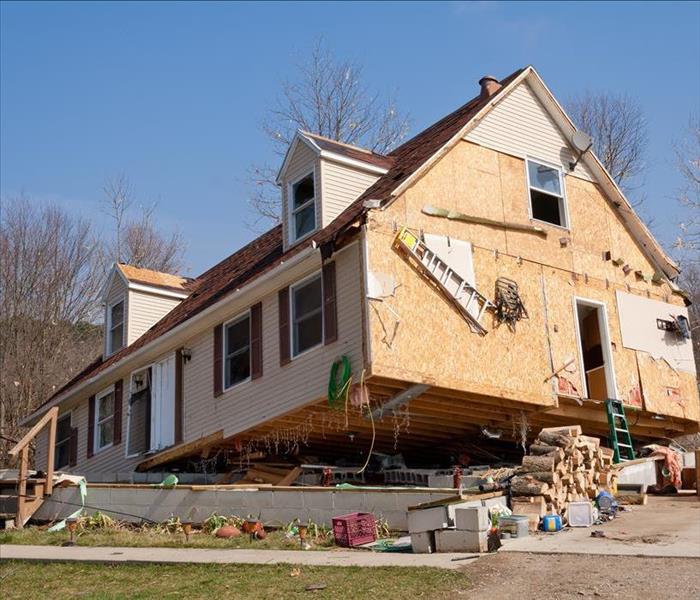 A Home Damaged by a Tornado in Lapeer, MI
A Home Damaged by a Tornado in Lapeer, MI
Storm season is upon us and while we may not reside in “Tornado Alley,” Michigan still sees its fair share of tornadoes. Many of us have been bless to never have experienced an actual tornado, yet I’m sure we’ve all been under a tornado warning. Well we hope that none of you will be caught in one, SERVPRO wants to give you some tips and knowledge that can help save your life if you’re ever staring down a tornado.
TORNADO 101
First things first, what is a tornado and what causes them? A tornado is a violently rotating column of air which descends from a thunderstorm to the ground. No other weather phenomenon can match the fury and destructive power of a tornado. A tornado can destroy large buildings and lift 20-ton railroad cars right off the tracks. While scientist do not fully understand exactly how tornadoes are formed, they do know that a preceding supercell thunderstorm is needed. A supercell is an organized thunderstorm that contains very strong, rotating updraft. This rotation helps to produce severe weather events such as large hail, strong downbursts, and of course, tornadoes. Tornadoes form under a certain set of weather conditions in which three very different types of air need to come together in a specific way. It goes something like this:
Near the ground lies a layer of warm and humid air, along with strong south winds. Colder air and strong southwest winds lie in the atmosphere. Temperature and moisture differences between the surface and the upper levels create what is called instability, one of the necessary ingredient for tornado formation. Thank change in wind speed and the direction with height is known as wind shear. This is linked to the eventual development of rotation from which a tornado may form. A third layer of hot dry air becomes established between the warm, moist air at low levels and the cool, dry air upward. This hot layer acts as a cap and allows the warm air underneath to warm further, making the air even more unstable. Things start to happen when a storm system aloft moves east and begins to lift the various layers. Through this lifting process the cap is removed, in turn setting the stage for an explosive thunderstorm to develop as strong updrafts form. Complex interactions between the updraft and the surrounding winds may cause the updraft to begin rotating… and a tornado is born.
The Difference Between a Watch and A Warning
Your listening to the weather on the TV, your NOAA Weather Radio (don't got one? Get one!), or online. You hear that there’s a tornado watch/tornado warning. Do you know the difference? A tornado watch means that conditions are right for a tornado, and tornadoes are possible. This also means to remain alert and watch the sky. Watch for these danger signs that a tornado is immanent:
- Dark, greenish sky
- Large hail
- A large, dark, low-lying cloud (particularly if its rotating)
- A loud roar, similar to a freight train
If you are noticing any of these sign, you best take cover quickly. That brings us to a tornado warning. This means that a tornado has been spotted by a human eye or radar, and that it is moving towards you in the warning area. Take shelter immediately. Tornadoes are very unpredictable and just because it’s not on a bee-line course to you, doesn’t mean it won’t shift at any moment, change directions and end up in your backyard.
What to Do During a Tornado
So, a tornado warning has been issued and you’re directed to take cover immediately but you don’t know where to go for shelter… Here are the recommended safest places to go based on where you are:
- A Mobile Home/Trailer: Get out immediately and go to the lowest floor of any nearby building or storm shelter. Even if the mobile home is equipped with a tie-down system cannot withstand the force of a tornado’s winds.
- A Vehicle: If you can safely drive away from tornado, please do so. If there’s a sturdy structure available, go inside, go to the lowest floor possible. If you don’t have time or not sure if you have time, or you’re not sure which way the tornado is moving, you can stay in the vehicle, park it but leaving it running so the airbags will work. The airbags and the frame can offer some amount of protection but this is not absolutely safe. The other option is to get out of the car and lay down inside a ditch. See more in “Outside with no Nearby Structure” for what to do here.
- A Structure/Building: Seek shelter in the lowest level of the building (basement, storm cellar). Bring with you your NOAA Weather Radio, so you can get all alerts and updates. If there isn’t a lower level, go to the inner most room on the ground floor. Often a bathroom or laundry room can make a suitable shelter area because the water pipes reinforce the walls, providing a sturdier structure. Put as many walls between you and the outside and stay away from windows and doors. Get down on your knees and use your hands to protect your head and neck from any falling debris. You can cushion yourself with a mattress, but don’t cover yourself. Stay inside until the your certain that the storm had passed, as multiple tornadoes can emerge from the same storm.
- Outside with No Nearby Structure: Lie flat in a nearby ditch or depression and cover your head and neck with your hands. If you were in a vehicle, make sure you are far enough away from the vehicle so that it doesn’t tumble unto you. Beware of potential flooding in the ditch you are occupying. Do not get under an overpass or bridge, this will increase your risk of injury. You are safer in a low, flat location. Be aware of flying debris, a tornado can pick up significantly large objects and turn them into missiles. Flying debris causes the most tornado deaths.
You Survived a Tornado, Now What??
After a tornado passes and you need to take some additional safety measures. Wait some additional time to be sure that there are no additional tornadoes coming your way. Be careful as you leave you shelter, there might be some unseen damage and debris waiting for you on the other side of the doors. If your home or business has been damaged in the tornado, walk carefully around the outside and check for any injured or trapped people, and check for things like loose power lines, gas leaks, and general structural damage. Leave the area if you smell gas or if there is floodwater around the building. Call your insurance agent and file a claim. Take photos of all the damaged areas to your home, business, and/or vehicles. Call SERVPRO of Oak Park/Ferndale as well, 248.246.0790, we will be out to your home ASAP, usually within 2-4 hours, and we’ll begin emergency services right away as we wait to hear from the insurance company to confirm coverage and obtain approvals. If the destruction to your home or business is extensive, don’t freak out and panic. The American Red Cross and other volunteer agencies will arrive to your area with food and water, and to set up temporary housing and shelters. Regardless the amount of damage your home or business has suffered from this storm, SERVPRO can help. “We are faster to any size disaster!”
Steps to Recovering after a Storm
5/30/2017 (Permalink)
Bad weather can spring up without much warning. Most of the time when a bad thunderstorm is threatening your area, you hardly have enough time to find shelter. As a homeowner, it is important to think about these moments before they occur.
Do you have the correct insurance policy? Is your home going to be covered in the event of a disaster? Is the amount of coverage going to be enough to restore your home? Thinking about these questions BEFORE the storm damage occurs can make your life after much easier.
Before you do anything else, stop and make sure your home is covered for the following:
Water and Windstorm Damage
Debris and Tree Removal
Sewer Backup Due to Flooding
Sump Pump Failure Due to Flooding
Additional Living Expenses in Case a Storm Forces You Out of Your Home
Once you have the proper home insurance coverage for storm damage, you can feel safer during the event of a tragedy. Seeing your home in ruins after a major storm can be heartbreaking. It can be difficult for families to know how to move on from this misfortune. The best thing you can do for your family and for your home is to begin storm damage recovery immediately. If you have suffered loss or damage because of bad weather, take the following steps on how to recover:
Take Pictures of the Damage
As soon as you are able, you need to start documenting the damage that has been done to your home. The trick to good storm damage recovery is keeping solid records of the damage. This includes noting any conversations that you have with your insurance agency and with the restoration company about the damage. You should be able to provide them with pictures and evidence of the destruction.
Make an Insurance Claim
It is crucial that you contact your home insurance agency immediately after your home suffers from storm damage. This is one of the biggest steps in storm damage recovery. Your homeowner’s insurance company should be able to provide you with support and structure for moving this process forward to restoring your home.
To start, you should find an exact copy of your homeowner’s insurance policy and determine if the damage exceeds your deductible. You will then need to work with your insurance company to get the necessary money and repairs completed. They will be able to refer you to local restoration companies, some may have preferred contractors that they will recommend, but the decision is ultimately yours as to who you chose to use. Once you have made your decision, report it back to your insurance company.
Finding a contractor that works directly with your insurance company is your best option, and it will save you time and hassle. Being the man in the middle of the two companies can be difficult. There are some contractors who make it their goal to work directly with your insurance company (SERVPRO is one of them) to improve communication during the project. This will take a lot of stress and pressure off you during this difficult time.
Make Temporary Repairs
Once all the proper claims have been made and the damage has been reported correctly, you can begin to make some temporary repairs. These repairs don’t have to be major reconstructions, and they don’t have to last your family forever. You can start by making your home livable again.
If you have suffered roof damage, place a tarp or plastic material over your roof to keep your home from being damaged further by additional rain. Begin the water mitigation process by having all the wet, destroyed materials removed and drying equipment put in place to prevent further damage from microbial growth. If you have lost a wall or large portion of your home, work on closing off that section of your house until you can do more permanent repairs.
Allow Your Family to Recover Slowly
Home repairs do not have to be completed all at one time. Storm damage can take several months to fully recover from and it is important to give your family the time that need. It might take a while before your home is fully restored to its former glory, but it is important that you take your time and get the job done correctly.
Call SERVPRO of Oak Park/Ferndale if you find yourself victim of Mother Nature’s wrath. We are a preferred contractor for most insurance companies and we can work directly with any insurance company to take that stress off your hands, you have enough to worry about. Just give us a call at 248-246-0790 after your insurance claim has been made and we’ll handle the rest.
Flood Insurance Vs. Sewer Backup Coverage, Are you covered??
5/18/2017 (Permalink)
Flood insurance and sewer backup insurance are not the same thing, nor are they included in your standard homeowner’s policy. It is important to understand the difference between the two, whether you have them, and if you need one or the other… or both!
Floods are the most devastating natural disaster in the US each year causing billions in losses and displacing thousands. While flooding is a common concern for those near rivers and streams, all homes in the US can be caught off-guard by floods. Floods are defined as surface water that enters your home for the outside. A flood can be caused by spring run-off, melting snow, an overflowing river, lake or stream, or even a swimming pool. Excessive groundwater buildup that enters your home via leaks or seepage is also considered flooding.
Sewer back-ups occur when massive volumes of water overload a drainage system. Once the waste water rises above your basement drains, it pushes up into your home through not just those floor drains but your sinks, tubs and any other drainage outlet. Sewer back-up can be a smelly, filthy mess and can introduce black mold, harmful bacteria, and sewage waste into your home, creating health risks and extensive damage.
Both these events can be caused by heavy rainfall, and if you don’t have the proper coverage. you will be footing the bill for this. It is important to know what coverages you have. Based on where you live, one of these may not be logically for you to carry. Here are some facts flood insurance you should consider:
- All flood insurance policies are backed by the federal government, they set all rates.
- Flood insurance never covers contents in a basement. It only covers the basement’s foundation and drywall, it does not cover carpeting, paneling, or tile.
- Most flood insurance polices just cover the dwelling, in case the home is swept away in the flood.
- You can purchase flood insurance for the contents in the main floor, but it will increase your premium.
- Flood insurance will cover certain major appliances like furnaces, air conditioners, freezers, etc. but it will not cover stereos, televisions, furniture or other contents.
- Enter your address into FloodSmart.gov’s One Step Flood Risk Profile tool and the site will tell you how likely it is that your property will be flooded
- There’s a limit on government coverage.You can get upwards of $250,000 on the structure of your home, which in most parts of the U.S. is going to be enough.
- Flood insurance involves water coming into your home from rain, a river, a lake, or external source of water. Flood insurance does not cover water sewer backup, even though this may be caused by excessive rain water.
Sewer back-up coverage can be added as an endorsement to your homeowner’s policy. This endorsement covers physical loss to property covered by your policy if the loss is caused by a discharge of water or waterborne material from a sewer, drain or sump. For a loss to be covered, the sewer, drain or sump must be located on premises listed in the endorsement. Here are some facts to consider:
- Sewer back-ups are somewhat a common occurrence.
- The cost can vary, but the typical sewer backup endorsement will cost under $100.
- With sewer backup, you purchase specific amounts of coverage, i.e. $10,000; $15,000 or $20,000. This helps cover the cost of cleaning and mitigating the damage caused from the backup as well as replacing carpets, drywall, personal contents, even cleaning ducts.
- There are some exclusions to the endorsement, one being floods, as well as poor maintenance, power failure, nor will it cover the cost of repairing the sewer or drain.
- Metro Detroit residences should all carry sewer backup coverage, especially if they plan to finish their basement and keep a lot of stuff in there.
Understanding the difference between these two add-on coverage's in lieu of your homeowner’s policy is very important and can save you thousands of dollars if South Eastern Michigan experiences more of the epic rainfall that happened August 2014. If you have more questions or don’t know what coverage you do have, call your insurance agent and find out. Ask questions, be informed. SERVPRO of Oak Park/Ferndale had a lot of customers that found themselves coming out of pockets $30,000+ to repair their homes after that storm, we don’t want this to happen to you.
When Storms or Floods hit Metro Detroit, SERVPRO is ready!
6/22/2016 (Permalink)
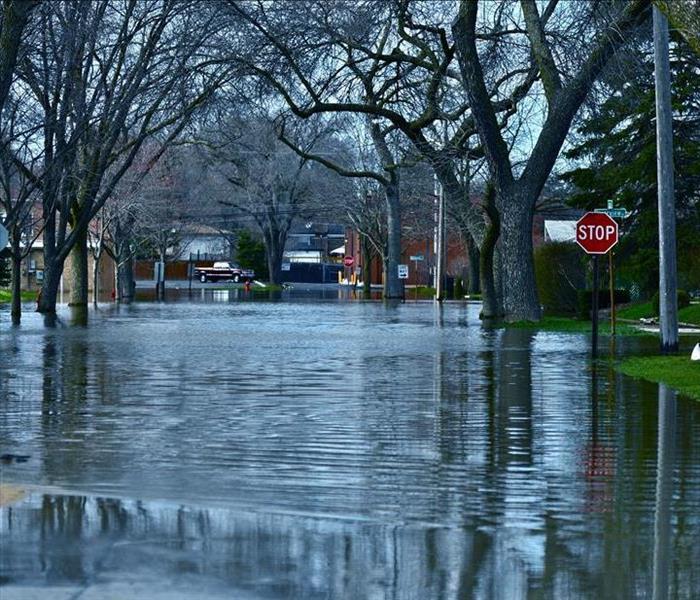 Our highly trained crews are ready to respond 24/7 to storm or flood damage in Metro Detroit.
Our highly trained crews are ready to respond 24/7 to storm or flood damage in Metro Detroit.
SERVPRO of Oak Park/Ferndale specializes in storm and flood damage restoration. Our crews are highly trained and we use specialized equipment to restore your property to its pre-storm condition.
Faster Response
Since we are locally owned and operated, we are able to respond quicker with the right resources, which is extremely important. A fast response lessens the damage, limits further damage, and reduces the restoration cost.
Resources to Handle Floods and Storms
When storms hit Metro Detroit, we can scale our resources to handle a large storm or flooding disaster. We can access equipment and personnel from a network of 1,650 Franchises across the country and elite Disaster Recovery Teams that are strategically located throughout the United States.
Have Storm or Flood Damage? Call Us Today 248-246-0790




 24/7 Emergency Service
24/7 Emergency Service





